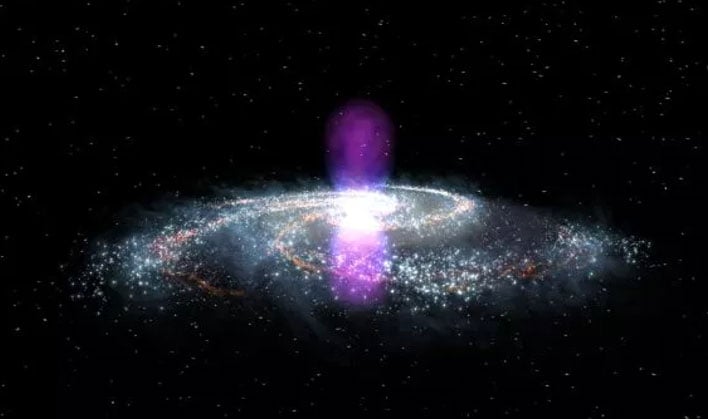What happens when the universe gets indigestion? Massive bubbles form at the middle of the
Milky Way, and then astronomers and scientists get to debate what it all means. They've been doing exactly that when, in 2020, the X-ray telescope eRosita discovered a pair of enormous bubbles at the center of the galaxy. The discovery of the gaseous bubbles sparked an intense debate to their origin, and the authors of a new study think they have finally figured it out.
The bubbles plume above and below the center of the galaxy. In a study posted to
Nature Astronomy, researchers say they were created around 2.6 million years ago when a
supermassive black hole gorged on all light and matter around it, resulting in a powerful jet of activity that lasted 100,000 years (we've all been there, right?).
"Using numerical simulations, we show that this model could successfully reproduce the morphology and multi-wavelength spectra of the observed bubbles and haze, which allows us to derive critical constraints on the energetics and timescales of the outburst," the study's authors wrote.
 NASA illustration of Fermi bubbles (Image Credit: NASA Goddard)
NASA illustration of Fermi bubbles (Image Credit: NASA Goddard)
Key to the theory is the resemblance of the massive bubbles to the Fermi bubbles discovered in 2010 by NASA's Fermi Gamma-ray Space Telescope. Due to the similar size and shape of those bubbles to the more recently discovered ones, the researchers surmised a single event had to have led to their formation.
These are not ordinary bubbles as you might recognize them from those tubes of soapy water you can get at the dollar store. They measure 11 kiloparsecs tall. A parsec is 3.26 light years, so we're talking about structures that span 36,000 light years high. For reference, the Milky Way galaxy is 30 kiloparsecs in diameter.
The study, led by the National Tsing Hua University in collaboration with the University of Michigan and the University of Wisconsin, highlights two competing models to explain the bubbles. One is called Fermi, which surmises they came from an exploding star, and the other is eRosita.
It's the second model that the study supports. Using a computer simulation, the researchers support the notion that a supermassive black hole and not an exploding star formed this bubbles.
"We not only can rule out the starburst model, but we can also fine tune the parameters that are needed to produce the same images, or something very similar to what’s in the sky, within that supermassive black hole model," University of Michigan astronomer Mateusz Ruszkowski said. "We can better constrain certain things, such as how much energy was pumped in, what’s inside these bubbles and how long was the energy injected in order to produce these bubbles."
One of the reasons why the researchers say their model rules out the Fermi theory is because of the length of time a starburst would take to form the bubbles—around 10 million years. In contrast, their model accurately predicts the size of both the eRosita X-ray and Fermi gamma ray bubbles.
"Our simulation is unique in that it takes into account the interaction between the cosmic rays and gas within the Milky Way. The cosmic rays, injected with the jets of the black hole, expand and form the Fermi bubbles that shine in gamma rays," said Karen Yang, lead author of the study.
Top Image Credit: ESA/Gaia/DPAC, CC BY-SA 3.0 IGO

